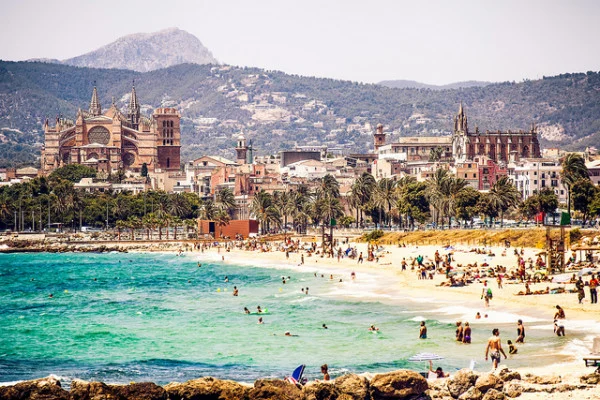Palma, the picturesque capital of Mallorca, lures travelers with its charming streets, historic architecture, and vibrant culture. Yet, just like any destination, there exists a time when the idyllic Palma transforms into a less-than-ideal getaway. In this article, we delve into the nuances of timing, exploring the worst time to visit Palma and how to navigate the challenges it presents.
High and Dry: Summer Woes in Palma
Palma’s siren song is strongest during the summer months when the sun bathes the city in a warm glow. However, this is precisely when the pitfalls begin to emerge. From June to August, Palma experiences a surge in tourism, transforming its narrow streets into bustling thoroughfares. The heat can be oppressive, with temperatures often soaring above 30°C (86°F), making outdoor exploration uncomfortable and exhausting.
Culture Clash: Overwhelmed by Crowds
One of the quintessential aspects of Palma is its rich cultural tapestry, woven through its museums, galleries, and historic sites. Unfortunately, during the peak summer season, these cultural gems become hotspots for crowds. Navigating through the Cathedral of Santa Maria and the Royal Palace of La Almudaina can feel more like a marathon than a leisurely stroll, detracting from the immersive experience that these treasures offer.
Transitioning from one point of interest to another becomes a test of patience rather than an enjoyable exploration of the city’s history and art. The vibrant local culture is somewhat diluted as tourists outnumber locals, making it harder to connect with the authentic essence of Palma.
Transportation Woes: A Tangle of Traffic
Palma’s public transportation system is generally efficient, but during peak tourist seasons, it can be challenging to navigate. Buses and taxis are in high demand, leading to longer wait times and increased traffic congestion. Renting a car might seem like a viable alternative, but the surge in visitors also means finding parking spaces becomes a frustrating mission, turning the convenience of a rental into a headache.
Rainy Days and Sullen Skies: The Off-Peak Blues
While summer presents its challenges, the off-peak seasons, particularly the late fall and winter months, come with their own set of drawbacks.
Rainfall Woes: Weathering the Storm
Palma experiences increased rainfall from October to February, often leading to soggy streets and a dampened travel spirit. Exploring the city’s outdoor attractions, like Bellver Castle or the Passeig des Born, becomes less enjoyable when rainclouds loom overhead. The occasional downpour may force visitors to alter plans, seeking shelter indoors and missing out on the charm of Palma’s al fresco experiences.
Cultural Cool Down: Off-Peak Closures
Palma takes a bit of a cultural hiatus during the off-peak months. Some attractions, particularly those outdoors, may close or operate on reduced hours. This includes the Bellver Castle’s outdoor areas, which may be inaccessible during inclement weather. For culture enthusiasts seeking a comprehensive exploration of Palma’s heritage, this can be a significant disappointment.
Accommodation Alternatives: Finding the Silver Lining
The off-peak season, however, does bring a silver lining in terms of accommodation. Hotels and vacation rentals often offer lower rates, and availability is more abundant. This is an opportune time for budget-conscious travelers who are willing to trade off some outdoor activities for the affordability and tranquility that the off-peak season brings.
Navigating the Calendar: Finding the Sweet Spot
So, when is the ideal time to visit Palma? Striking a balance between the peak and off-peak seasons is key. Consider planning your trip during the shoulder seasons of spring (March to May) or early fall (September to October). During these times, the weather is generally pleasant, and the crowds are more manageable, allowing for a more immersive and enjoyable experience.
Cultural Resurgence: Springtime Blooms
In spring, Palma comes alive with the vibrant colors of blooming flowers. The city’s parks and gardens, such as the Parc de la Mar, become enchanting havens for relaxation and appreciation of nature. Cultural attractions are less crowded, allowing for a more intimate engagement with Palma’s rich history and art.
Transportation Ease: Navigating with Comfort
During the shoulder seasons, transportation is more reliable. Buses run on schedule, taxis are easier to find, and the overall pace of the city is more relaxed. Exploring Palma’s various neighborhoods becomes a joyous adventure rather than a logistical challenge, enhancing the overall travel experience.
Conclusion
In the vibrant tapestry of Palma, timing plays a pivotal role in the quality of your experience. While the worst time to visit Palma may vary for different travelers, understanding the seasonal nuances and planning accordingly can make all the difference.
Before booking your tickets and packing your bags, consider the weather, cultural events, and the ebb and flow of tourist crowds. Whether you choose to embrace the summer heat or revel in the tranquility of the off-peak season, being aware of the challenges and opportunities each time frame presents ensures a more informed and enjoyable visit to the captivating city of Palma.
Remember, Palma is not just a destination; it’s a journey through time and culture, and choosing the right moment to embark on that journey makes all the difference.
